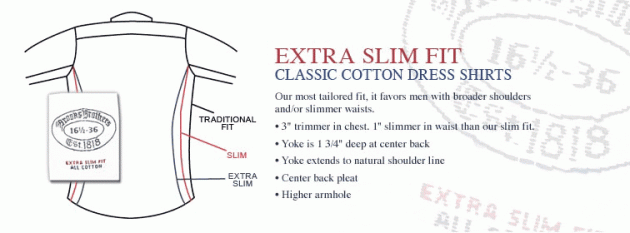Dress Shirts for Men 101
Several times each month, a family member, friend, colleague, or reader will ask me about dress shirts for men. Questions range from what to look for in a quality dress shirt to the names of some of the best shirtmakers in the world. For the sake of efficiency, I sat down this weekend and wrote a beginner’s guide to dress shirts for men, which can serve as a reference. This makes it easier for people to find, and save me time because I can point to it whenever a question arises, not having to repeat myself.
A History of Dress Shirts for Men
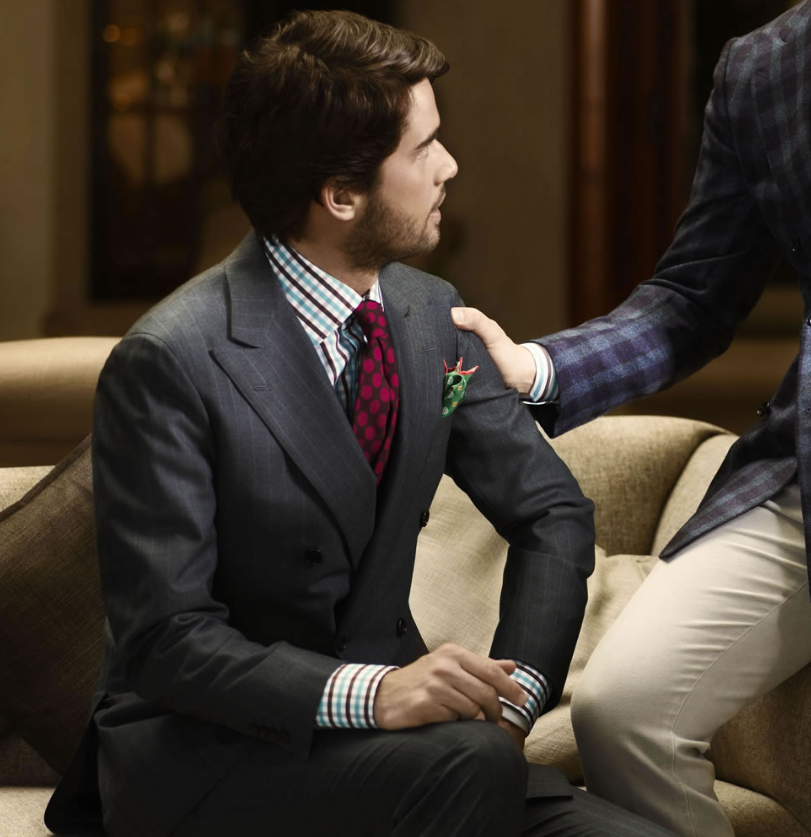 A majority of men in the United States have never designed a dress shirt. A century ago, all shirts were custom made to your specifications. You would walk into a store like J.C. Penney, look at fabrics, have measurements taken, and six weeks later, a shirt would show up manufactured for you.
A majority of men in the United States have never designed a dress shirt. A century ago, all shirts were custom made to your specifications. You would walk into a store like J.C. Penney, look at fabrics, have measurements taken, and six weeks later, a shirt would show up manufactured for you.
Then, retailers figured out they could save a lot of money by making large runs of limited patterns in a handful of pre-designed sizes. Customers could walk into a store, get a decent approximate fit, and have instant gratification. This dropped costs substantially and, within a generation or two, most men had no idea that there was any other way to order shirts.
In fact, even the term “dress shirt”, which signifies a more formal pattern as contrasted to “sports shirt”, which is a more casual fabric and style, only became necessary with the rise of the t-shirt as everyday clothing. Our great grandparents would have called a dress shirt nothing more than “a shirt”. It was what people wore. There really were no other kinds of shirts suitable for wearing in public.
This created an interesting split in society. Those who had sufficient resources, or the sartorial culture, in their family continued to have their dress shirts designed, tailored, and manufactured specifically for them. Those who lacked these inheritances believed that shirts were something you bought off a rack from a local discount retailer. Nowhere is this split more evident than if you walk into a shirtmaker’s showroom floor with someone who doesn’t know the process. I’ve heard several friends remark about great clothiers, “I stopped in once but didn’t see anything I liked, so I left.” They truly have no idea that for every one dress shirt on the showroom floor, there are 100x as many fabrics in the shirting fabric books; that the clothing on the racks are mere samples.
Bespoke vs. Made-to-Measure vs. Off-the-Rack Dress Shirts for Men
When you are looking at dress shirts for men, all shirts will fall into one of three categories: Bespoke, Made-to-Measure, or Off-the-Rack.
- Bespoke Shirts are completely custom designed for you based on a pattern drawn to fit your exact body size and preferences. Once your pattern is on file, you can order new shirts any time you want simply by flipping through fabric books. You have total control and virtually anything you can sketch or describe can be made.
- Made-to-Measure Shirts are modified based on a set of existing patterns to adjust for your own measurements and limited preferences. If you have a fairly standard body type with ordinary proportions, there isn’t an enormous difference between made-to-measure shirts and bespoke shirts. It may or may not be worth the additional money for you to pay for bespoke. Your pattern adjustments can be kept on file so you can reorder when you find a new fabric you love without needing to get re-fitted.
- Off-the-Rack Shirts are based on pre-established sizes and limited shirting fabrics, often by neck size / sleeve size for men. For example, a 16.5/33-34 would be a 16.5″ neck with a 33″ to 34″ arm.
Off-the-rack shirts can be great bargains if you shop intelligently (e.g., during the day-after-Christmas sale at Nordstrom, dress shirts from Italian shirtmaker Canali are priced at huge discounts, taking $275 retail shirts down to $165), you fit comfortably into a standard size, and you are lucky enough to find a pattern you like. If you are looking for decent dress shirts for men to wear under a sweater or with a pair of blue jeans, off-the-rack shirts have their place. The problem you are likely to face is one of experience. Once you’ve become accustomed to having your shirts fit exactly how you want, move precisely how you desire, feel just as you like them, and be made to your specifications and personality quirks, it can be very difficult to accept anything else, even if the alternative is nice.
All else equal, even a $500 off-the-rack shirt is going to be inferior to you, as a wearer, than a $200 made-to-measure or bespoke shirt. It always amazes me, for example, to see people buying Charvet or Brioni shirts off-the-rack at the Saks flagship store in New York when, for very little additional money, you could have them custom made to your specifications in the respective showrooms of each fashion house.
My rule of thumb: If you are willing to invest a little bit of money into your wardrobe, you should never pay more than $250 for an off-the-rack shirt, and even that is pushing it. Beyond that price, if you are intelligent about your purchasing, you can get a much higher quality made-to-measure or bespoke shirt in the fabric of your choice, personalized down to the cuff style, collar style, and cut (“fit”) by a great shirting house.
Speaking for myself, I have no problem buying inexpensive clothes off-the-rack for casual summer ware. In fact, I am partial to the $15 shorts sold at J.C. Penney for hot summer days when I want to sit outside and read with a glass of water and flip flops. When it comes to dress shirts, I want spare-no-expense comfort since I like feeling good, and looking good, all day. That makes buying off-the-rack difficult. The last dress shirt I bought off-the-rack was a Breuer gingham at Saks for $225 nearly a year ago.
This is not a screed against off-the-rack clothing. For some people, a nicer shirt has no marginal utility to them. That is perfectly acceptable. Other people should not buy nicer clothes due to their financial situation; they’d be better off repaying credit card debt or buying a home. In short, the reason you’d buy bespoke or made-to-measure instead of off-the-rack is the same reason you’d pick a Bentley or a Lexus over a Ford. You buy it because it is nicer and you can afford it.
The Primary Fit Styles for Dress Shirts for Men
Once you’ve chosen between bespoke, made-to-measure, and off-the-rack, you need to pick a fit. The fit you select will depend on your body type and your personal preference.
- Slim Fit shirts are tailored in the chest, waist, and arms for a closer, sleeker look. It has nothing to do with being “slim” or “fat”. If you like your clothes high, tight, and tailored, you probably prefer a slim fit.
- Extra Slim Fit or Super Slim Fit shirts are a more extreme version of the slim fit.
- Regular Fit shirts are typically close to a traditional shirting fit with slightly tapered sides.
- Traditional Fit shirts are cut more like a box.
Here is a good diagram provided by retailer Brooks Brothers (you can see my visit to the flagship store in New York here) to explain the difference between the different fits you might find in most dress shirts for men.
The Heart of Every Dress Shirt for Men Is Shirting Fabric
Once you have selected your manufacturing method (bespoke, made-to-measure, or off-the-rack) and a fit (slim fit, extra slim fit, regular fit, or traditional fit), the next thing you need to think about is the shirting fabric. I’ve shown you pictures of the process of choosing shirting fabrics in the past.
There is nothing quite as good in the world as the perfect shirting fabric. Just like colognes or music, movies or books, food and friends, everyone has very specific personal tastes when it comes to shirting fabrics. Some people like non-iron smooth-as-crisp-bedsheet fabrics, while others like soft-hug-you-like-cashmere-warm-to-the-touch cottons. Some men prefer lightweight shirting fabrics, while others would rather wear a heavier, more substantial material.
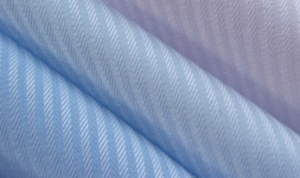
I prefer rich, textured textile shirting fabrics that change color in the light or have intricate weaves in them.
Seasonality and climate play a big role in the right shirting fabrics. During summer, I am partial to lightweight, clean, smooth shirting fabrics in casual patterns such as ginghams, whereas in winter, I want heavy, rich, dense textiles like textured herringbone with complex patterns that feel like being wrapped in a blanket. I also like extremely bright or rare colors, that are then hidden under cashmere sweaters, blazers, sports jackets, or suits because I have a penchant for clothes with a hidden personality – like Mrs. White removing her jacket in the 1980’s “Clue” movie. (Some of my most conservative dark suits have vibrant silk linings in gold and purple that is only visible when and if I remove my jacket.)
Regardless of where you buy your shirt, or who constructs it for you, virtually all quality shirting fabrics originate at a handful of mills. Generally speaking, the best shirting fabrics will come from brands such as ALUMO, Thomas Mason, Cotonificio Albini, Otolina, David John Anderson, Grandi and Rubinelli, T.E.S.T.A, Ermenegildo Zegna, Dormeuil, Holland & Sherry, Vitale Barberis Canonico, and Loro Piana.
If you have nice clothes, your closet is filled with textiles produced by these mills, even though you’ve probably never heard of them. The only widely recognized fabric mill that successfully made the transition to fashion house, designing, manufacturing, and selling directly-to-end-customers and through third party distributors such as high-end department stores, is Emenegildo Zegna. The rest are content to make their textiles and then sell them to tailors, shirtmakers, fashion designers, and clothing lines, who then use it as raw material to create products for their customers. If a particular designer wants a custom textile, they can draw it, then approach one of the mills to make a limited batch that is sold exclusively to them.
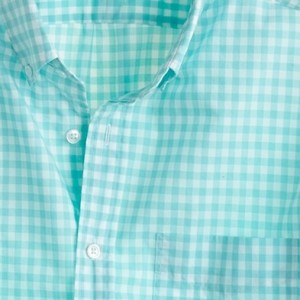
Thomas Mason Shirting Fabric
For example, many high-end custom shirtmakers use Thomas Mason fabrics. You could walk into the showroom of one of these shirtmakers, flip through their fabric books, and design a custom shirt in, say, Tadly Gingham. Yet, if you walked into a J. Crew Store this season, you would see an off-the-rack Tadly Gingham dress shirt for $135. The J. Crew designers created the shirt, ordered the fabric from Thomas Mason, and then had it massed produced in limited sizes with no personalization to bring the cost down to more affordable levels.
The price of the shirting fabric used depends upon the complexity and quality of materials that go into it. A rich, complex textile that has lot of detail costs more than a basic cotton. A high quality Sea Island Cotton is going to cost more than your run-of-the-mill cotton.
To learn the difference between different shirting fabrics used in dress shirts for men, such as twill, brushed twill, broadcloth, pinpoint oxford, oxford cloth, royal oxford, dobby, batiste, gingham, herringbone, pima cotton, sea island cotton, and Egyptian cotton, read this guide. It has pictures to help you identify each, and explains some of the differences.
The Skill of the Tailor or Shirtmaker Who Makes the Dress Shirt Determines Construction Quality
The next component of the cost of dress shirts for men is the shirtmaker. The same shirting fabric in the hands of two different artisans can turn out wildly different.
Finding a shirtmaker that fits with your style and personality is one of the most important decisions you can make when it comes to your wardrobe. Each shirtmaker is going to have different quality levels, showroom experiences, and personalities. One might be in a mahogany-paneled showroom on the upper East Side of New York City where attentive staff help you build a wardrobe as soft, classical music plays in the background. Another might be in the garment district, in a bare-floor workshop with people furiously cutting, sewing, and perfecting their work. One might be excellent at creating tight, tailored Italian-inspired shirts, whereas another might excel at more traditional English shirts.
In this sense, when it comes to dress shirts for men, brand names are just a clue; a proxy to help the uniformed determine quality. Those who know what makes a great shirt great can judge a garment on sight. Those who don’t need to rely on the past reputation of shirtmakers. The names that garner the most respect in the shirtmaking world, Charvet and Turnbull & Asser, do so because they are known for the outstanding quality construction of their garments. Even so, you fill find some people that can’t stand either shirtmaker for one reason or another. It’s a subjective industry.
What makes a high quality dress shirt for men? For a complete list, I recommend this guide. The short list:
- The threat count should be at least 80, with 120/140 or higher being better. (This doesn’t stand for threads per inch as people commonly assume, but rather yarn size; e.g., 200s means there are 200 hanks (1 hank = 840 yards) of yarn in one pound.)
- Buttons should be mother-of-pearl or other high-quality material.
- Buttons should be stitched with a criss-cross “X” pattern for reinforcement.
- All stitches in the garment should be straight and parallel to the seam.
- The collar should be well-constructed and stiff enough to maintain its shape.
- The collar should have removable collar stays, which are put in before wearing and taken out before laundering. These help the collar retain its shape and stay in place throughout the day. You can get cheaper, plastic collar stays or a set of really nice brass or mother-of-pearl collar stays.
- There should be no bunching of fabric at the end of the collar on a high quality dress shirt.
- Fabric patterns should match up throughout the garment. For example, in a striped dress shirts, the stripes should match from the shoulder to the arms. If you are paying money to have good quality merchandise, you deserve to have something that is well-structured. Unfortunately, some shirtmakers are inconsistent in this area. I’ve seen $50 department store shirts where the pattern matching is perfect and $300 made-to-measure Brooks Brothers shirts with horrific mismatches where the sleeves meet the body of the shirt. Good shirtmakers with top-shelf reputations will pay attention to those details.
- Many men who are dress shirt aficionado insist on reinforced side gussets.
Each shirtmaker is going to carry his own selection of shirting fabrics from the mills we discussed earlier, and many can even work with you to create a custom shirt if you have procured the fabric yourself somehow (e.g., you were on vacation in China and saw a beautiful textile that you bought and now want turned into a sport shirt to wear with jeans).
Collar, Cuff, Placket, and Other Options
One of the most enjoyable parts about commissioning dress shirts for men is the ability to choose your cuff style, collar style, placket style, and other options, such as whether you want a pleat in the back or a pocket in the front. Every reputable shirtmaker offers different options and can provide samples of what they look like to help you make a selection. Certain body types and face types look better in certain styles, which is where a good shirtmaker’s expertise really shines.
A List of the Best Shirtmakers in the World
Here is a reasonably complete list of some of the best shirtmakers in the world. Arguably, the two most famous high-quality shirt makers in the world are Charvet in Paris, France, and Turnbull & Asser in London, England.
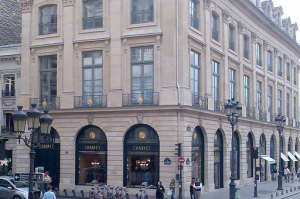
Charvet in Paris is considered by many to be the greatest shirtmaker in the world.
One of the reasons Charvet is so famous is their policy of carrying more on-site shirting fabrics in their Paris flagship store than any other shirtmaker on the planet, turning it into a veritable playground for men. Other brands are considered nice; e.g., a Brooks Brothers made-to-measure shirt is a very good value, especially during the semi-annual 25% off private sales events.
In most shirting fabrics, prices range from $100 to $600 per dress shirt, with some shirtmakers requiring a minimum order of several shirts. A well constructed dress shirt for men should last for several years. My wardrobe still contains some great shirts in classic designs that are 10 years old and still look as new as the day I received them.
There is also an enormous difference in quality between different shirtmakers. You need to compare that quality to the price they are charging.
For example, if someone says, “Do you consider a Thomas Pink shirt a good shirt?” That is a somewhat difficult question because you also have to account for value. At $180 per shirt, or $200 after taxes, I’m not thrilled that a Thomas Pink shirt doesn’t offer mother-of-pearl buttons and a few other touches. I wouldn’t be willing to pay full retail, even though I might pay twice that for a bespoke shirt from another fashion house. Yet, during the Thomas Pink semi-annual sale with discounts as high as 40%, I would consider it a good buy. It’s a bit like saying, “Is a Mercedes C Class a good car?”. Yes, it is, but not at the same price as a Mercedes S Class, a Lexus or a Bentley.
- Charvet
- Turnbull & Asser
- Luigi Borrelli
- Brioni
- Kiton
- Emenegildo Zegna
- New & Lingwood
- Budd Shirt Makers
- Ascot Chang
- Harvie & Hudson
- Hilditch & Key
- Thomas Pink
- Ralph Lauren Purple Label
- Dege & Skinner
- Geneva Custom Shirts
- CEGO Custom Shirtmaker
- Anto
- Tom Ford
- Canali
- Ede & Ravenscroft
- Gieves & Hawkes
- Paul Stuart
- Hamilton Shirts
- Charles Tyrwhitt
- Brooks Brothers
There are many more; this is just a starting point. Almost all top shirtmakers from Europe have American trunk shows in major cities throughout the country, allowing you to get fitted by their tailor.
When You Buy a Dress Shirt for Men, You Are Paying for 4 Things
A final word on pricing. When you buy a dress shirt for men, or even a sport shirt, you are paying for four things:
- The shirting fabric
- The skill of the tailor or shirt maker
- The prestige value of the label
- The markups to cover middlemen and end-retailer costs
The best shirting fabrics are going to cost more, the best tailors and shirtmakers can charge more for their time, and even the best known brands can demand a premium by virtue of their reputations, some of which took centuries to build. The higher up the food chain you go in the world of bespoke shirting, there is no middleman, in which case you pay the sticker price. If you want Turnbull & Asser shirts, you can’t bargain shop; you go to Turnbull & Asser and commission shirts.



